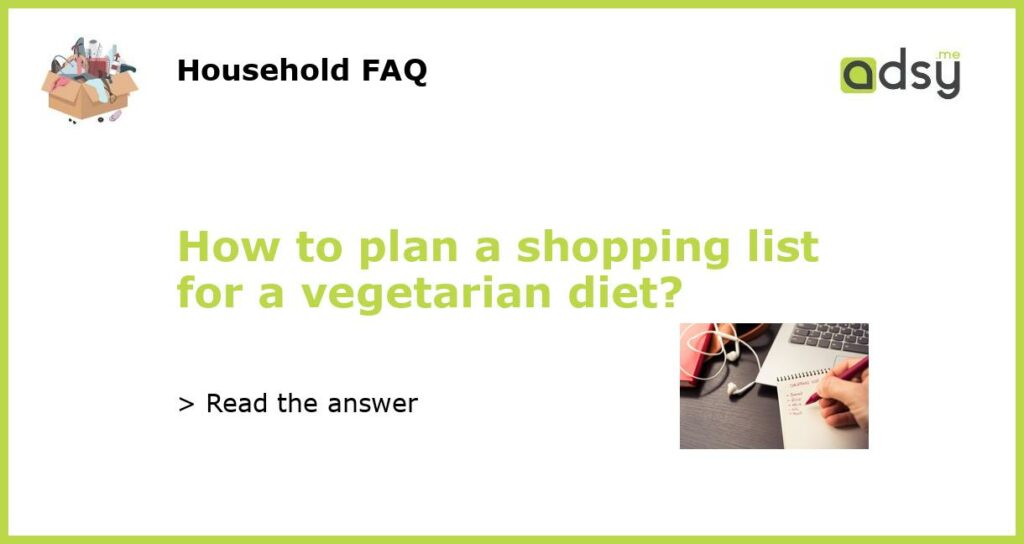Understanding the Basics of a Vegetarian Diet
A vegetarian diet is based on the exclusion of meat, poultry, and fish from one’s daily meals. Instead, plant-based foods such as fruits, vegetables, grains, legumes, nuts, and seeds form the foundation of a vegetarian diet. It is important to understand the different types of vegetarian diets before planning a shopping list.
Different Types of Vegetarian Diets and Their Considerations
There are various types of vegetarian diets, each with its own set of rules and restrictions:
- Lacto-ovo vegetarian: This diet includes dairy products and eggs.
- Ovo-vegetarian: Eggs are allowed, but dairy products are excluded.
- Lacto-vegetarian: Dairy products are included, but eggs are excluded.
- Vegan: This diet excludes all animal products, including dairy, eggs, and even honey.
- Pescatarian: Although not technically a vegetarian diet, it includes fish and seafood while excluding other meat.
Considering which type of vegetarian diet you follow is essential for planning an appropriate shopping list.
Essential Nutrients for a Balanced Vegetarian Diet
A well-balanced vegetarian diet must provide all the necessary nutrients for optimal health. Here are some key nutrients to consider when planning your shopping list:
- Protein: Include plant-based protein sources such as legumes, tofu, tempeh, seitan, and quinoa.
- Iron: Include iron-rich foods like spinach, kale, lentils, tofu, and fortified cereals.
- Calcium: Opt for calcium-fortified plant milk, tofu, almonds, sesame seeds, and leafy greens.
- Vitamin B12: Consider incorporating fortified foods or taking a B12 supplement.
- Omega-3 fatty acids: Include walnuts, flaxseeds, chia seeds, and seaweed for a plant-based source of omega-3s.
Creating a Detailed Shopping List
Now that you understand the basics of a vegetarian diet and the essential nutrients to consider, it’s time to plan your shopping list. Here are some tips to help you create a detailed list:
- Plan your meals: Take some time to think about what meals you’ll be preparing for the coming week. This will help you identify specific ingredients you’ll need.
- Include a variety of fruits and vegetables: Aim to choose a range of different colored fruits and vegetables to ensure you get a variety of nutrients.
- Include plant-based protein sources: Add items like lentils, chickpeas, tofu, or tempeh to your list to ensure you meet your protein needs.
- Stock up on whole grains: Include foods such as quinoa, brown rice, oats, and whole wheat bread to provide fiber and essential nutrients.
- Don’t forget healthy fats: Incorporate sources of healthy fats such as avocados, nuts, and seeds to provide essential nutrients and promote satiety.
- Consider dairy alternatives: If you follow a non-dairy vegetarian diet, make sure to include calcium-fortified plant milk and other dairy alternatives on your list.
- Check for recipe-specific ingredients: If you plan on trying out new vegetarian recipes, make sure to check for any specific ingredients you’ll need and add them to your list.
Additional Tips for Vegetarian Shopping
Here are a few extra tips to keep in mind while planning your vegetarian shopping list:
- Read labels: Pay attention to food labels to ensure the products you choose align with your dietary preferences, especially when it comes to hidden animal-based ingredients.
- Buy in-season produce: Opt for seasonal fruits and vegetables as they tend to be fresher, more flavorful, and more affordable.
- Shop in bulk: Buying in bulk can save money and reduce packaging waste. Stock up on staples like beans, grains, and nuts.
- Try new plant-based products: Explore the variety of plant-based alternatives available, such as plant-based burgers, sausages, and dairy-free cheeses.
- Support local farmers: Consider visiting local farmers’ markets to support local agriculture and find fresh, locally sourced produce.






